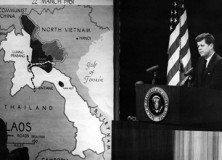The Kennedy Administration and American Military Assistance to Laos — Christine Gilbert

INTRODUCTION:
From 1954 until the mid-1970s, Laos was the scene of substantial American political and military intervention as successive administrations attempted to forestall the establishment of a communist government in the newly independent Lao kingdom. Despite its short tenure, the Kennedy administration was particularly important in committing the U.S. government to a policy of steadfast covert military assistance to non-communist factions in the Lao civil war. Indeed, Kennedy not only markedly shifted American strategy in support of a neutral coalition government, but also established unique country team structures that endured for over a decade. The 1975 communist victory in Laos has led most analysts to characterize the American assistance effort as an exercise in futility. However, several assessments of U.S. involvement also note the unique levels of innovation and interagency coordination the U.S. assistance program achieved despite relatively limited resources.
STRATEGY:
Though the President encountered bureaucratic and other resistance in his diplomatic endeavors, Kennedy’s pursuit of a neutral government political settlement in Laos was a deliberate strategy that employed military and diplomatic tools to advance American objectives. The post-Geneva Accords military assistance program, by contrast, evolved in a relatively ad hoc fashion in response to in-country events as the administration sought to preserve the neutral Lao government.
INTEGRATED ELEMENTS OF NATIONAL POWER:
Bureaucratic conflict, at times, obstructed policy formation in Washington. In contrast, the U.S. Government agencies in the field—notably USAID, Department of Defense, CIA, and Department of State officials in Laos—demonstrated impressive levels of cooperation empowered by the authority of the U.S. Ambassador. Civil-military conflict was manifested in coordinating the air war, but overall the U.S. Country Team achieved notable integration of the elements of national power despite limited resources and other obstacles.
EVALUATION:
Presidentially empowered ambassadors, detachment from Washington, Country Team innovation and expertise, as well as flexible funding structures appear responsible for producing a united assistance effort in Laos. Yet, bureaucratic tensions and entrenched Washington world-views also created shortcomings in strategy development and implementation.
RESULTS:
Overall, the literature emphasizes the costs of American involvement, most commonly the financial toll, the failure of American objectives, and U.S. as well as Lao casualties.
CONCLUSION:
In addition to offering distinct insight on country team cooperation in a remote and challenging theater, the study also illustrates patterns of policy-making within the Kennedy administration serving as an interesting example of American involvement in unconventional warfare, an increasingly important aspect of present-day U.S. national security policy. In analyzing the U.S. government’s approach to the Laos crisis under Kennedy, authors note the worthwhile nature of the Geneva Accords and the achievements of a united, unorthodox country team. In the end, however, analysts agree that Kennedy-era policy towards Laos proved unsuccessful. The diplomacy of the Geneva Accords, could not bring peace and covert military assistance was likewise incapable of defeating communism in Laos.